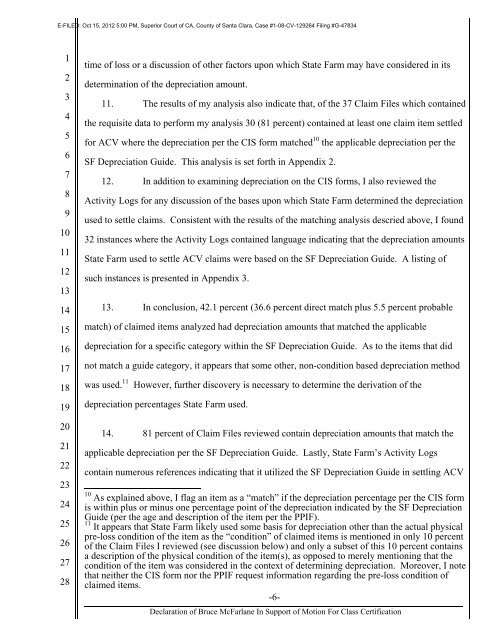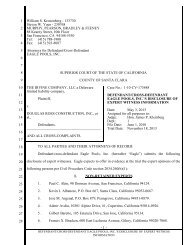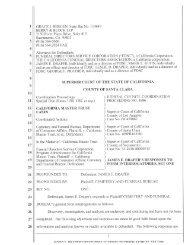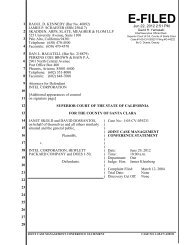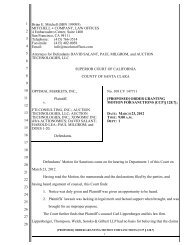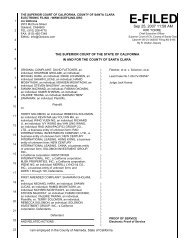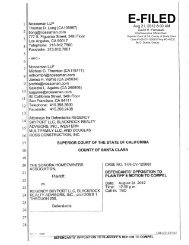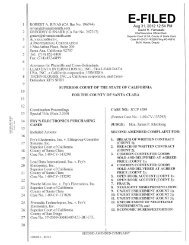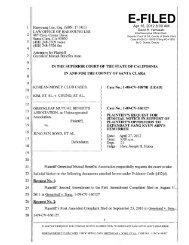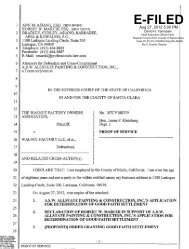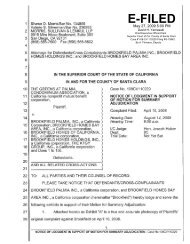E-FILED - SC Superior Court E-Filing
E-FILED - SC Superior Court E-Filing
E-FILED - SC Superior Court E-Filing
- TAGS
- www.scefiling.org
You also want an ePaper? Increase the reach of your titles
YUMPU automatically turns print PDFs into web optimized ePapers that Google loves.
E-<strong>FILED</strong>: Oct 15, 2012 5:00 PM, <strong>Superior</strong> <strong>Court</strong> of CA, County of Santa Clara, Case #1-08-CV-129264 <strong>Filing</strong> #G-47834<br />
1<br />
2<br />
3<br />
4<br />
5<br />
6<br />
7<br />
8<br />
9<br />
10<br />
11<br />
12<br />
13<br />
14<br />
15<br />
16<br />
17<br />
18<br />
19<br />
20<br />
21<br />
22<br />
23<br />
24<br />
25<br />
26<br />
27<br />
28<br />
time of loss or a discussion of other factors upon which State Farm may have considered in its<br />
determination of the depreciation amount.<br />
11. The results of my analysis also indicate that, of the 37 Claim Files which contained<br />
the requisite data to perform my analysis 30 (81 percent) contained at least one claim item settled<br />
for ACV where the depreciation per the CIS form matched 10 the applicable depreciation per the<br />
SF Depreciation Guide. This analysis is set forth in Appendix 2.<br />
12. In addition to examining depreciation on the CIS forms, I also reviewed the<br />
Activity Logs for any discussion of the bases upon which State Farm determined the depreciation<br />
used to settle claims. Consistent with the results of the matching analysis descried above, I found<br />
32 instances where the Activity Logs contained language indicating that the depreciation amounts<br />
State Farm used to settle ACV claims were based on the SF Depreciation Guide. A listing of<br />
such instances is presented in Appendix 3.<br />
13. In conclusion, 42.1 percent (36.6 percent direct match plus 5.5 percent probable<br />
match) of claimed items analyzed had depreciation amounts that matched the applicable<br />
depreciation for a specific category within the SF Depreciation Guide. As to the items that did<br />
not match a guide category, it appears that some other, non-condition based depreciation method<br />
was used. 11 However, further discovery is necessary to determine the derivation of the<br />
depreciation percentages State Farm used.<br />
14. 81 percent of Claim Files reviewed contain depreciation amounts that match the<br />
applicable depreciation per the SF Depreciation Guide. Lastly, State Farm’s Activity Logs<br />
contain numerous references indicating that it utilized the SF Depreciation Guide in settling ACV<br />
10<br />
As explained above, I flag an item as a “match” if the depreciation percentage per the CIS form<br />
is within plus or minus one percentage point of the depreciation indicated by the SF Depreciation<br />
Guide (per the age and description of the item per the PPIF).<br />
11<br />
It appears that State Farm likely used some basis for depreciation other than the actual physical<br />
pre-loss condition of the item as the “condition” of claimed items is mentioned in only 10 percent<br />
of the Claim Files I reviewed (see discussion below) and only a subset of this 10 percent contains<br />
a description of the physical condition of the item(s), as opposed to merely mentioning that the<br />
condition of the item was considered in the context of determining depreciation. Moreover, I note<br />
that neither the CIS form nor the PPIF request information regarding the pre-loss condition of<br />
claimed items.<br />
-6-<br />
Declaration of Bruce McFarlane In Support of Motion For Class Certification


